Archive
- Behind the Screens 9
- Bright Young Things 16
- Colour Palette 64
- Dress Ups 60
- Fashionisms 25
- Fashionistamatics 107
- Foreign Exchange 13
- From the Pages of… 81
- G.U.I.L.T. 10
- Little Trifles 126
- Lost and Found 89
- Odd Socks 130
- Out of the Album 39
- Red Carpet 3
- Silver Screen Style 33
- Sit Like a Lady! 29
- Spin, Flip, Click 34
- Vintage Rescue 20
- Vintage Style 157
- Wardrobe 101 148
- What I Actually Wore 163
Style Inspiration: Clara Bow
Celebrating the Roaring Twenties in a Special Series
 It’s no secret I love the style of the 1920s, although Louise Brooks is usually more my speed than Clara Bow. However, last year I saw the 1927 WWI film Wings, starring Clara Bow, and take a fashion cue from her. Most of the film was set on the battlefields of France, but there is a scene at the beginning where the actress is wearing a scarf tucked into her belt, on top of a sweater and pleated knit skirt outfit. ‘I like that!’ I thought when I saw it, ‘I must try it at home.’
It’s no secret I love the style of the 1920s, although Louise Brooks is usually more my speed than Clara Bow. However, last year I saw the 1927 WWI film Wings, starring Clara Bow, and take a fashion cue from her. Most of the film was set on the battlefields of France, but there is a scene at the beginning where the actress is wearing a scarf tucked into her belt, on top of a sweater and pleated knit skirt outfit. ‘I like that!’ I thought when I saw it, ‘I must try it at home.’
It’s great watching period films and seeing how clothes were really worn – I especially like to check out what the extras are wearing, because they usually will be dressed in more ordinary clothes than the glamorous star of the film.

The Outfit
I am wearing a mix of modern and 70s items. The outfit was a deliberate combination of quiet beige and tan tones paired with robins egg blue. Of the latter, the skirt is a linen/poly mix, and I bought it in a charity store for just a few dollars. I was particularly pleased with that find because it was almost exactly the same as a vintage 40s skirt I’d been eyeing on Etsy, which was much more expensive. I would love to own a vintage 20s cardigan – my modern version features beautiful detailing and is a very warm merino wool, by Nanette Lepore.

The Accessories
Also 70s, the leather handbag came from a Melbourne vintage boutique. The mint green silk scarf and perforated leather belt are recent charity store finds – the latter immediately became a favourite accessory. The cream wool beret has been part of my wardrobe for nearly twenty years, while the cashmere/silk blend socks by Phillip Matignon, the patent leather Mary Janes by John Lewis Women (both bought from an online sale site) and the sunglasses by MinkPink have never been worn by anyone else. The blue chalcedony earrings I made myself, and the turquoise ring is a souvenir from Barcelona.
It tickles me that this Twenties daytime look is entirely made up from garments from other eras! But that marches perfectly well with my creed of never looking like I’ve stepped off a period film set. Even if this time I’ve deliberately paid homage to a film star.
Picture Note
The background images were taken last year at my cousins’ farm on the outskirts of Melbourne.
On the Beaton Track

Derby Day fashions during the Melbourne Spring Racing Carnival are traditionally all about black and white. It is a striking combination, but it is not uncommon to see ladies in all black or all white, or possibly shots of colour as well. Perusing pictures of fashions on the field always calls to mind Audrey Hepburn’s extravagant ensemble in the film My Fair Lady.
Cecil Beaton was not a minimalist. Not if his costume designs for My Fair Lady are anything to go by. I must now make a controversial confession: I think most of the outfits, if not all, are just plain hideous. (If only they were plain though – I’d probably like them more!)
There is such a superfluity of tulle, frills, ruffles, and fabric roses that Audrey looks like she is in danger of being swallowed alive.
Recently I watched the film again for the first time since I was a teenager, and I was very surprised to find I disliked the fashions. While the film is set in the Edwardian era, Beaton’s costume design shows an unmistakable influence of the Sixties (my least favourite era for fashion) – not to say a heavy-handed touch. There is such a superfluity of tulle, frills, ruffles, and fabric roses that Audrey looks like she is in danger of being swallowed alive.
There are a multitude of enormous bows too, but I like those – there is something pleasing about the shape of a bow. While it could be argued a bow is girlish too, it has ties (pardon the pun) to practicality and function that redeem it from fussiness, even when it is merely decorative.
 Audrey Hepburn in My Fair LadyAudrey’s Ascot outfit (above) featured several black and white striped bows trimming her hat and lace dress. I was very familiar with it from black and white photographs, but I was shocked when I saw it on film. There were coloured flowers trimming the hat, and – most appalling detail of all – a white lace mobcap (stuffed with more fake flowers) that sat atop Audrey’s head beneath the main body of the hat! Horrible.
Audrey Hepburn in My Fair LadyAudrey’s Ascot outfit (above) featured several black and white striped bows trimming her hat and lace dress. I was very familiar with it from black and white photographs, but I was shocked when I saw it on film. There were coloured flowers trimming the hat, and – most appalling detail of all – a white lace mobcap (stuffed with more fake flowers) that sat atop Audrey’s head beneath the main body of the hat! Horrible.
But big hats were certainly in favour with Beaton. He designed additional costumes for the Broadway version of the film, and these are real hats, not a stupid little fascinator among them. These hats aren’t for wallflowers however. They are graphic, sculptural pieces with a solid structural foundation supporting the lighter bows and feather trim. In graphic black and white they posses rather more gravitas than they would rendered otherwise in bright colour. Though size is surely set on maximum, ironically these are far more minimal in design than real Edwardian hats.
 Costume by Cecil BeatonIn my own adventures in hat-wearing, it has been interesting to discover how important hairstyle is. Less so from a fashion or silhouette point of view than practicality. In the Edwardian era women had long hair that was invariably worn in an elaborate updo, usually with additional false pieces to create volume. To counter sudden gusts of wind, the enormous hats of the time were securely pinned on with hatpins, and this is the main reason a woman rarely removed her hat when not indoors. My own hat – a 1960s cartwheel – is enormously wide and a mere elastic band is not enough to hold it securely on a blustery day.
Costume by Cecil BeatonIn my own adventures in hat-wearing, it has been interesting to discover how important hairstyle is. Less so from a fashion or silhouette point of view than practicality. In the Edwardian era women had long hair that was invariably worn in an elaborate updo, usually with additional false pieces to create volume. To counter sudden gusts of wind, the enormous hats of the time were securely pinned on with hatpins, and this is the main reason a woman rarely removed her hat when not indoors. My own hat – a 1960s cartwheel – is enormously wide and a mere elastic band is not enough to hold it securely on a blustery day.
 I have mixed eras in this outfit inspired by Derby Day: a 1940s-style dress, vintage 40s lace gloves, a 1960s hat and modern shoes by Australian label Skin.Conversely, the close-fitting cloche hat of the 1920s made shorn hair mandatory. I know this to be true – before I bobbed my own hair it was impossible to jam on a cloche if I pulled my hair back into a chignon to mimic the look of a bob (and the proportions looked silly with my hair down).
I have mixed eras in this outfit inspired by Derby Day: a 1940s-style dress, vintage 40s lace gloves, a 1960s hat and modern shoes by Australian label Skin.Conversely, the close-fitting cloche hat of the 1920s made shorn hair mandatory. I know this to be true – before I bobbed my own hair it was impossible to jam on a cloche if I pulled my hair back into a chignon to mimic the look of a bob (and the proportions looked silly with my hair down).
Scroll down to see additional pictures of Cecil Beaton’s costumes for the Broadway production of My Fair Lady. (Click the images to jump through to even more of these costume designs.)
Mode à la Daisy
Celebrating the Roaring Twenties in a Special Series
 À la Daisy :: Tinto 1848 // C-Type Plate // No flashOne of Daisy Buchanan’s accessories I liked in The Great Gatsby was her black and geometric print white headscarf. I looked at it, admired it and thought, “I can do that.” I have a long geometric silk scarf already and have worn it today, double wrapped and tied above my left ear. It’s received the approval from my fellow fashionistas in the office too.
À la Daisy :: Tinto 1848 // C-Type Plate // No flashOne of Daisy Buchanan’s accessories I liked in The Great Gatsby was her black and geometric print white headscarf. I looked at it, admired it and thought, “I can do that.” I have a long geometric silk scarf already and have worn it today, double wrapped and tied above my left ear. It’s received the approval from my fellow fashionistas in the office too.
 Carey Mulligan as Daisy Buchanan and Leonardo DiCaprio as Jay Gatsby in a scene from “The Great Gatsby
Carey Mulligan as Daisy Buchanan and Leonardo DiCaprio as Jay Gatsby in a scene from “The Great Gatsby
Replicating Rachael
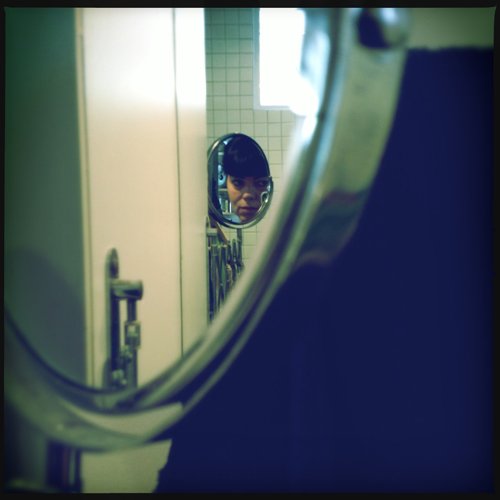 I always loved that scene in Blade Runner when Deckard scans the photograph and enlarges and enlarges to find one of the replicants reflected in a mirror. Here’s my attempt in my tiny bathroom.Before I cut off my hair last October, I decided to do a few dress-ups that required long hair. As I had also recently acquired a 70s-does-40s black crepe dress (complete with rhinestone brooch on the left shoulder), the time was ripe for a little homage to Sean Young’s Rachael in Blade Runner.
I always loved that scene in Blade Runner when Deckard scans the photograph and enlarges and enlarges to find one of the replicants reflected in a mirror. Here’s my attempt in my tiny bathroom.Before I cut off my hair last October, I decided to do a few dress-ups that required long hair. As I had also recently acquired a 70s-does-40s black crepe dress (complete with rhinestone brooch on the left shoulder), the time was ripe for a little homage to Sean Young’s Rachael in Blade Runner.
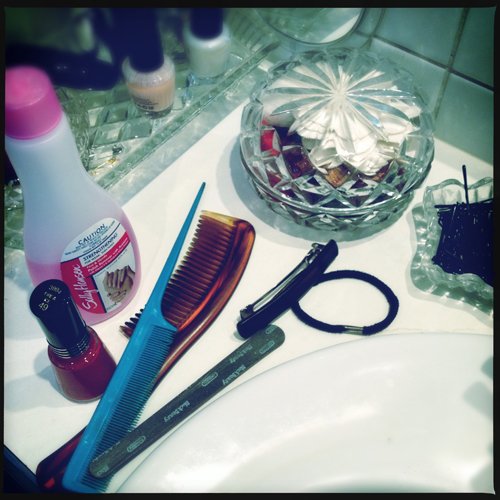 Tools for becoming Rachael
Tools for becoming Rachael Such a tease …The first thing to do was tease my hair, which is always a difficult task because my hair is fine and soft and tends to flop pretty quickly. I don’t know – maybe I’m just not hard-core enough with my teasing and hairspray. I always shudder at doing such violence to my hair, and the thought of combing it out afterwards makes me chicken out from going all the way. I created some rather modest ‘boofs’ (that’s Aussie slang for big hair): big puffs on either side of my centre parting.
Such a tease …The first thing to do was tease my hair, which is always a difficult task because my hair is fine and soft and tends to flop pretty quickly. I don’t know – maybe I’m just not hard-core enough with my teasing and hairspray. I always shudder at doing such violence to my hair, and the thought of combing it out afterwards makes me chicken out from going all the way. I created some rather modest ‘boofs’ (that’s Aussie slang for big hair): big puffs on either side of my centre parting.
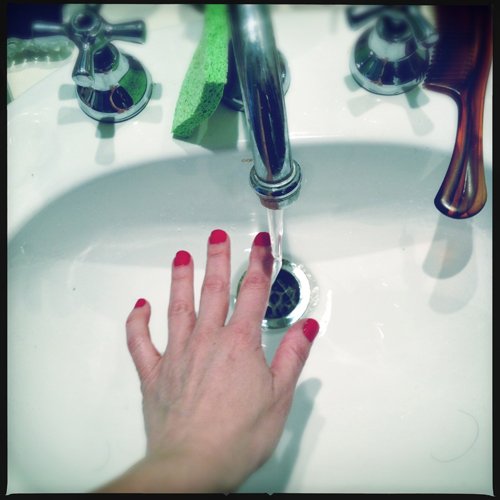 An important step in the nail polish drying process: running waterRed nail polish was required (Revlon Fire & Ice); a dunk under cold running water speeds up the drying process. The super-fun part of the makeup process was using my Majic instant eye shadow, which reminds me of that scene in The Fifth Element where Milla Jovovich uses a Chanel product to instantly apply some pretty cool eye makeup. Lots of black smudgy eyeliner and some browny-pink lipstick with some gloss over the top finished the look.
An important step in the nail polish drying process: running waterRed nail polish was required (Revlon Fire & Ice); a dunk under cold running water speeds up the drying process. The super-fun part of the makeup process was using my Majic instant eye shadow, which reminds me of that scene in The Fifth Element where Milla Jovovich uses a Chanel product to instantly apply some pretty cool eye makeup. Lots of black smudgy eyeliner and some browny-pink lipstick with some gloss over the top finished the look.
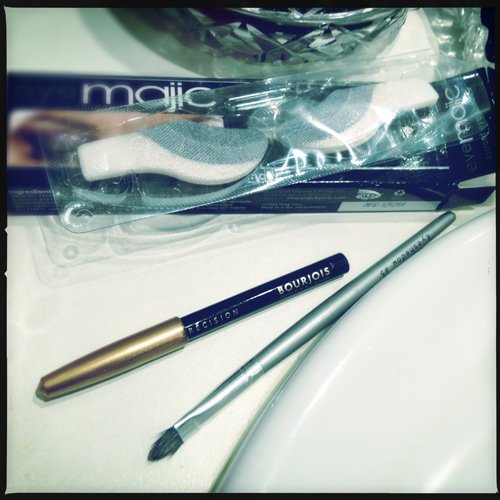 Channelling Rachel via Leeloo with Majic instant eye shadow
Channelling Rachel via Leeloo with Majic instant eye shadow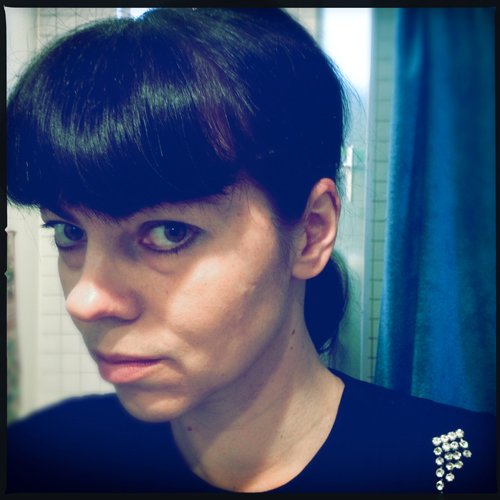 Smudge that eyeliner, roll back that hairI don’t own any enormous-shouldered jackets similar to Rachael’s sharp jacket – I eschew shoulder pads almost entirely – except for a fitted jacket from the early 90s by old label Blasé, which is also secondhand. A rolled-up piece of office paper simulates Rachael’s cigarette. But the most important part is replicating Rachael’s defiant, dead-eyed stare just before Deckard cross-examines her.
Smudge that eyeliner, roll back that hairI don’t own any enormous-shouldered jackets similar to Rachael’s sharp jacket – I eschew shoulder pads almost entirely – except for a fitted jacket from the early 90s by old label Blasé, which is also secondhand. A rolled-up piece of office paper simulates Rachael’s cigarette. But the most important part is replicating Rachael’s defiant, dead-eyed stare just before Deckard cross-examines her.
The thing that always amused me in the film is when Rachael takes down her perfectly coiffed, smooth hair in Deckard’s apartment, and suddenly it’s corkscrew curly! How does she do that? Is it a replicant thing – they can curl their hair at will? Because – barring having a hairdresser on hand at all times – that would be a handy skill to have.
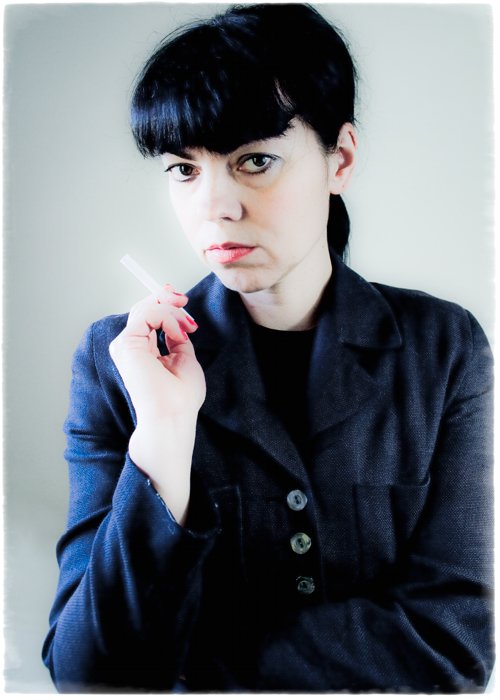 Princess Tatiana à la Rachael
Princess Tatiana à la Rachael
Replicant

One of my most-loved films from the 80s is Ridley Scott’s Blade Runner. I have a fondness for sci-fi, and it still remains one of the best, and probably always will. Sean Young’s costumes in the film are fabulous: an 80s take on the 1940s, one of my favourite eras for fashion. There are exaggerated shoulders and wasp waists galore. Filmmakers are rather fond of this 40s noir look for futuristic thrillers, and it does work deliciously.
I love in the film how Rachael starts off so very straight-laced, with precision makeup, and by the end as her world entirely unravels, her hair (previously lacquered smooth) is in a riot of fuzzy curls, and her eye makeup is smudged.
 Sean Young as Rachael in Ridley Scott’s Blade Runner (1982)
Sean Young as Rachael in Ridley Scott’s Blade Runner (1982) Sean Young as Rachael in Ridley Scott’s Blade Runner (1982)In the scene where Rachael ventures onto the mean streets and shoots Deckard’s would-be attacker, she wears an enormous fur coat with a collar that envelops her and shields her from the clammy air. That huge collar has always put me in mind of Elizabethan collars, although the fabrics used could not be more different.
Sean Young as Rachael in Ridley Scott’s Blade Runner (1982)In the scene where Rachael ventures onto the mean streets and shoots Deckard’s would-be attacker, she wears an enormous fur coat with a collar that envelops her and shields her from the clammy air. That huge collar has always put me in mind of Elizabethan collars, although the fabrics used could not be more different.
This Zara puffa bolero, when its shawl collar is flipped up has also always reminded me of the same Elizabethan craze for face-framing collars. The dress – which you can’t see at all – is a vintage 1970s-does-40s black crepe. My diamante earrings are actually vintage 40s.
 Sean Young as Rachael in Ridley Scott’s Blade Runner (1982)
Sean Young as Rachael in Ridley Scott’s Blade Runner (1982)






